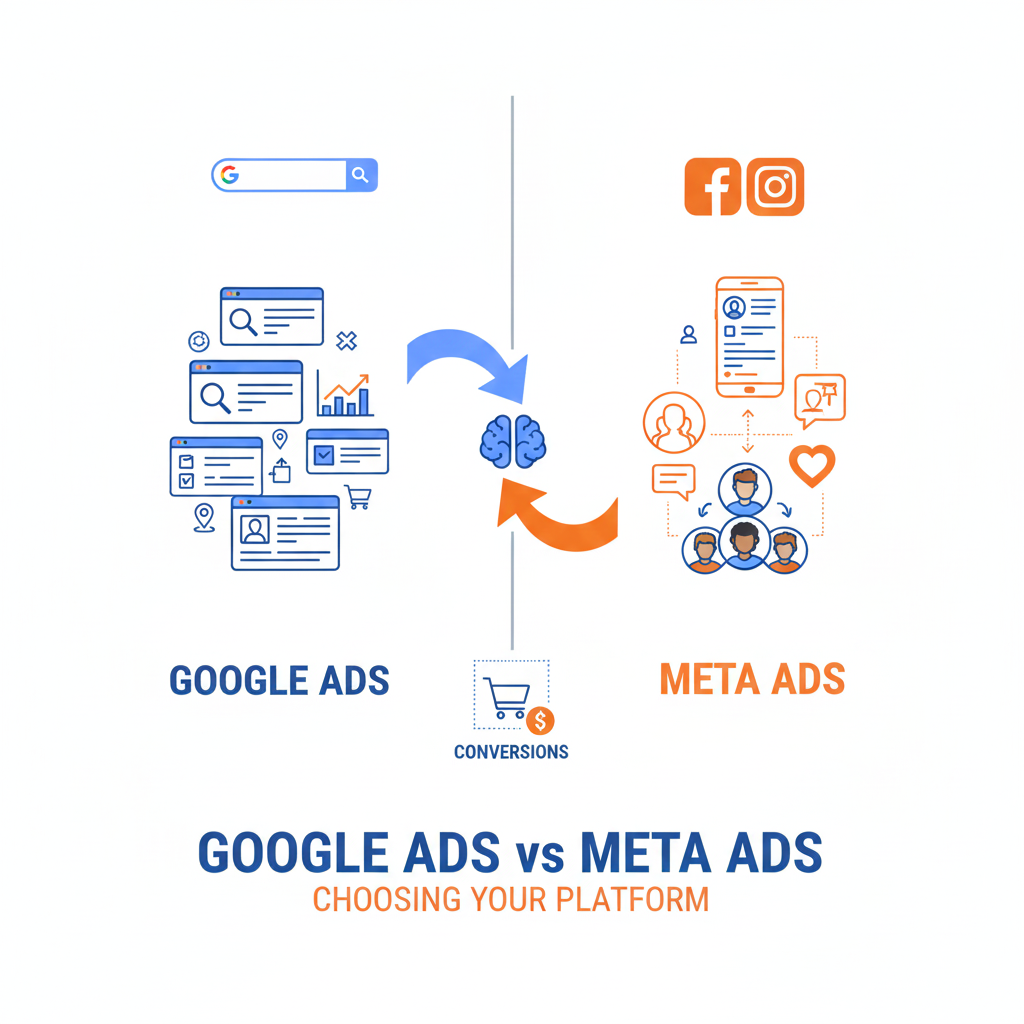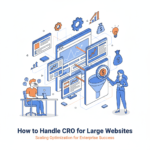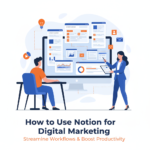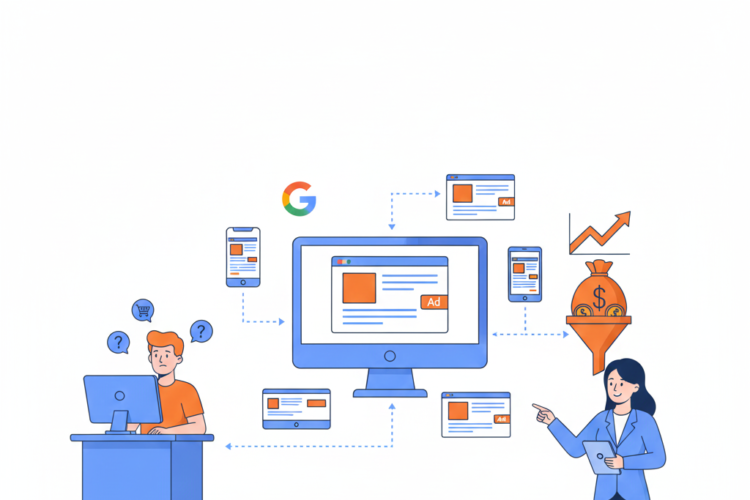
Google Ads vs Meta Ads: Deep Dive Comparison for Marketers in 2025
Table of Contents
-
Introduction
-
Overview of Google Ads
-
Overview of Meta Ads
-
Key Differences at a Glance
-
Ad Platforms and Ecosystems
-
Targeting Capabilities
-
Audience Intent & User Journey
-
Ad Formats and Creative Potential
-
Budgeting and Bidding Strategies
-
Analytics and Attribution Models
-
Industry Use Cases and Suitability
-
Performance Benchmarks
-
Challenges and Limitations
-
Integration with Other Tools
-
Which One Should You Choose?
-
Expert Opinions & Trends in 2025
-
Final Thoughts
1. Introduction
In the world of digital advertising, two platforms dominate the landscape — Google Ads and Meta Ads (formerly Facebook Ads). These platforms collectively drive billions in ad spend annually and serve as primary acquisition channels for millions of businesses. But while both offer robust advertising solutions, their foundations, audiences, formats, and strengths differ significantly.
This article aims to deliver a comprehensive comparison between Google Ads and Meta Ads — helping marketers, entrepreneurs, and agencies decide which platform aligns best with their goals.
2. Overview of Google Ads
Google Ads is the largest search advertising platform in the world, enabling advertisers to show their ads across the Google ecosystem, which includes:
-
Google Search
-
YouTube
-
Google Display Network (GDN)
-
Gmail
-
Google Shopping
-
Google Maps
Key Highlights:
-
Intent-driven advertising
-
Access to the world’s largest search engine
-
Powerful machine learning and bidding automation
-
Diverse ad formats including text, video, shopping, and app promotion
3. Overview of Meta Ads
Meta Ads includes Facebook, Instagram, Messenger, and Audience Network. It focuses on social engagement and audience behavior, allowing advertisers to create highly targeted campaigns based on user interests, behaviors, and demographics.
Key Highlights:
-
Audience-driven advertising
-
Visual-first ad formats
-
Strong community and brand interaction
-
Advanced audience segmentation (Lookalikes, Custom Audiences)
4. Key Differences at a Glance
| Feature | Google Ads | Meta Ads |
|---|---|---|
| Primary Intent | Demand capture | Demand generation |
| Ad Placement | Search, YouTube, Display | Facebook, Instagram, Messenger |
| Targeting Type | Keyword and intent-based | Audience and behavior-based |
| Format Strengths | Text, video, Shopping | Visual, Story, Carousel |
| User Journey Stage | Bottom-of-funnel | Top and mid-funnel |
| CPC Trend | Higher (esp. in Search) | Generally lower |
| Best For | Direct response, product searches | Brand engagement, storytelling |
5. Ad Platforms and Ecosystems
Google Ads Ecosystem
-
Search Network: Paid search ads triggered by keywords
-
Display Network: Banner ads across millions of sites
-
YouTube Ads: Skippable, non-skippable, bumper, and in-feed video ads
-
Shopping Ads: Product listings with price, rating, and merchant info
-
App Campaigns: Promotes app installs across Google’s properties
Meta Ads Ecosystem
-
Facebook Feed and Stories
-
Instagram Feed, Reels, and Stories
-
Messenger Ads
-
Audience Network: Ads shown in third-party apps and websites
-
Meta Advantage+ Campaigns: AI-optimized ad delivery
6. Targeting Capabilities
Google Ads Targeting
-
Keywords: Match user queries with your ads
-
Location & Language
-
Demographics
-
In-Market Audiences
-
Custom Intent & Affinity Audiences
-
Remarketing Lists
-
Customer Match (email-based)
Meta Ads Targeting
-
Detailed Targeting: Interests, demographics, behaviors
-
Custom Audiences: Based on website visitors, CRM lists, app activity
-
Lookalike Audiences: AI-generated audiences similar to your best customers
-
Location & Demographic
-
Ad scheduling, device, platform-based
🧠 Insight: Meta provides deeper behavioral and psychographic targeting, while Google shines in capturing search-based user intent.
7. Audience Intent & User Journey
Google Ads
-
Search = Intent
A user searching “best accounting software” is likely ready to compare and buy.
Meta Ads
-
Disruption & Discovery
Meta captures users during leisure time. Ads must be engaging enough to disrupt scrolling and spark interest.
Conclusion:
Use Google for high-intent moments. Use Meta to nurture interest and retarget creatively.
8. Ad Formats and Creative Potential
Google Ads Formats
-
Text Ads
-
Responsive Search Ads
-
Display Banners
-
Shopping/Product Ads
-
YouTube Video Ads
-
App Promotion Ads
-
Performance Max Campaigns (multi-format, multi-channel)
Meta Ads Formats
-
Image and Video Ads
-
Carousel Ads
-
Collection Ads (Shop)
-
Reels Ads
-
Story Ads (IG & FB)
-
Instant Experience
-
Lead Forms
Creative Note:
-
Meta is storytelling-first: It rewards lifestyle visuals, user-generated content, and engagement.
-
Google is utility-first: It thrives on direct messaging, urgency, and solution-oriented copy.
9. Budgeting and Bidding Strategies
Google Ads
-
Bidding Strategies:
-
Manual CPC
-
Maximize Clicks
-
Maximize Conversions
-
Target CPA/ROAS
-
-
Daily Budgets per campaign or ad set
-
Smart Bidding (AI-driven)
Meta Ads
-
Bidding Strategies:
-
Lowest Cost (automatic)
-
Cost Cap
-
Bid Cap
-
Minimum ROAS
-
-
Campaign Budget Optimization (CBO)
-
Ad Set Budgeting
ROI Tip:
Meta can be more cost-efficient for awareness. Google delivers higher-quality leads but often at a premium CPC.
10. Analytics and Attribution Models
Google Ads
-
Tracks performance via:
-
Google Ads Manager
-
Google Analytics 4 (GA4)
-
Conversion Tags
-
Enhanced Conversions
-
-
Attribution Models:
-
Data-driven (default)
-
Last Click
-
Linear, Time Decay, Position-based
-
Meta Ads
-
Meta Business Suite or Ads Manager
-
Conversion API (for better tracking in cookieless world)
-
Pixel-based tracking
-
UTM and GA4 integrations
-
Attribution Models:
-
1-day / 7-day click/view
-
Custom windows (with CAPI)
-
11. Industry Use Cases and Suitability
| Industry | Google Ads Strength | Meta Ads Strength |
|---|---|---|
| E-commerce | Shopping + Search + PMAX | Dynamic Product Ads + Reels |
| SaaS | Search queries with high intent | Education + Retargeting |
| Local Business | Google Maps + Local Services | Brand awareness + Lead Forms |
| Coaching/Consulting | Long-tail keyword targeting | Audience building, storytelling |
| Apps | App Campaigns | App install campaigns via Stories |
12. Performance Benchmarks (2024 Averages)
| Metric | Google Ads | Meta Ads |
|---|---|---|
| Avg. CPC | $2.69 (Search) | $1.01 |
| CTR | 3.2% (Search) | 1.7% |
| Conversion Rate | 4.4% (Search) | 3.1% |
| ROAS | 3.5x | 2.8x |
| CPM | $4–$7 (Display/YouTube) | $6–$12 |
Note: These are average values. Your performance will vary based on niche, ad creative, audience, and funnel.
13. Challenges and Limitations
Google Ads
-
High competition = Expensive CPCs
-
Platform complexity (Search vs Display vs PMAX)
-
Difficult for creatives to shine
Meta Ads
-
Ad fatigue happens faster
-
Pixel tracking less accurate post-iOS 14
-
Requires strong visual assets
14. Integration with Other Tools
-
Seamless with GA4, BigQuery, DV360, Firebase
-
Strong API support
-
CRM integration for Smart Bidding
Meta
-
CRM and email integrations (HubSpot, Klaviyo)
-
Zapier, Shopify, and WhatsApp integrations
-
Meta’s Business Suite is mobile-optimized
15. Which One Should You Choose?
| Scenario | Recommendation |
|---|---|
| Quick Lead Generation | Google Ads (Search) |
| Brand Building | Meta Ads |
| New Product Discovery | Meta Ads (Instagram, Reels) |
| Ecommerce Conversions | Combo: Google Shopping + Meta DPA |
| Retargeting | Meta is king |
| App Downloads | Google App Campaigns |
| Local Store Visits | Google Maps & Local Campaigns |
🎯 Pro Tip: In 2025, the best results come from integrated strategies using both platforms in harmony.
16. Expert Opinions & Trends in 2025
-
Performance Max campaigns are redefining Google Ads strategy with multi-surface targeting.
-
AI Creative Testing is booming on Meta.
-
Privacy-first attribution via Conversion API (Meta) and Enhanced Conversions (Google) is critical.
-
Short-form video ads (Reels, YouTube Shorts) are outperforming static images.
-
Automation and AI are reducing manual campaign optimization work — but creative strategy is more crucial than ever.
17. Final Thoughts
Both Google Ads and Meta Ads are essential weapons in a digital marketer’s arsenal. They serve different purposes, operate on different philosophies, and yield different results depending on your objective.
Google captures demand — when users know what they want.
Meta creates demand — when users are still discovering.
If you’re building a scalable marketing engine, your real power lies in combining both — using each platform at the right stage of the customer journey.
Author



